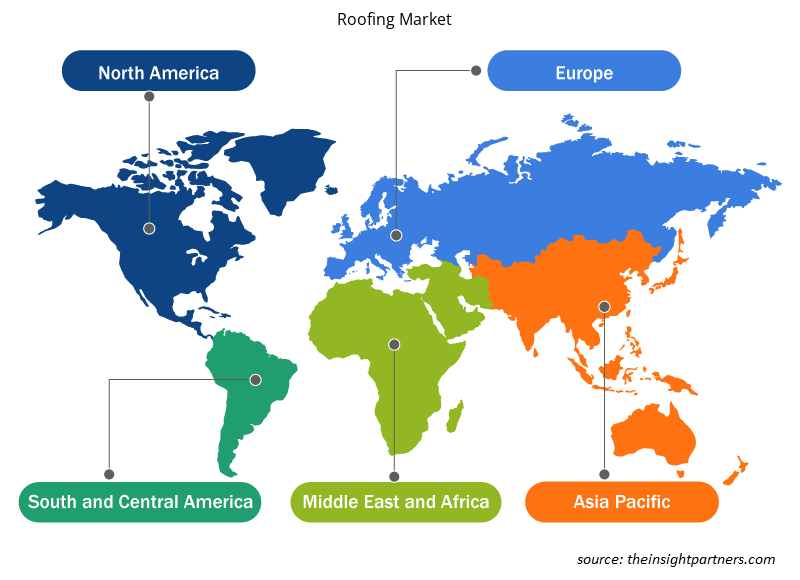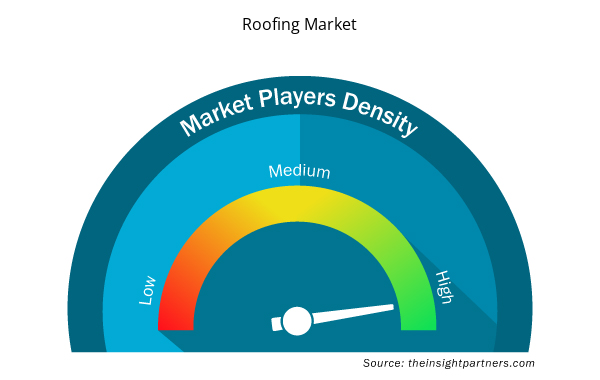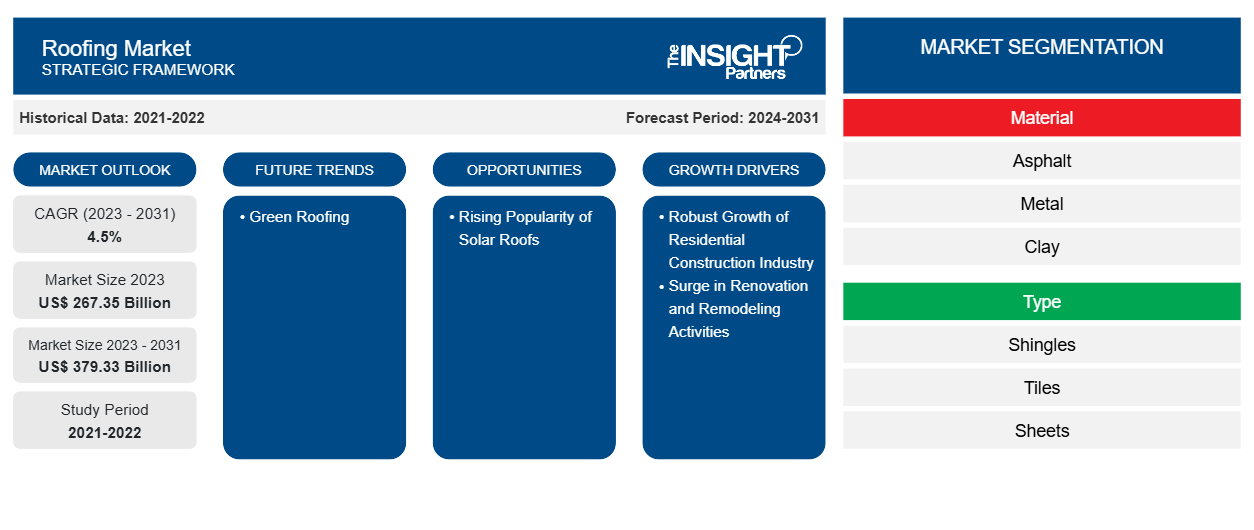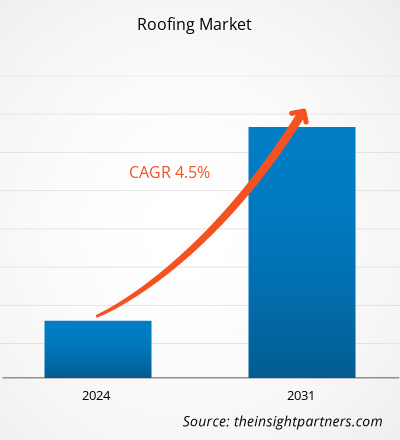屋顶市场规模预计将从 2023 年的 2673.5 亿美元增至 2031 年的 3793.3 亿美元。预计 2023-2031 年期间,该市场的复合年增长率将达到 4.5%。绿色屋顶方法对蓬勃发展的住宅建筑行业的影响可能仍是屋顶市场的一个关键趋势。
屋顶市场分析
随着城市化和基础设施建设的迅猛发展,建筑行业对屋顶系统的需求日益增加,例如沥青瓦、金属屋顶、粘土屋顶、混凝土瓦、石板瓦、木瓦、橡胶或塑料瓦。屋顶是建筑物不可或缺的一部分。状况良好的屋顶可以保护建筑物免受不可预见的情况的影响。建筑项目中对屋顶的要求围绕着对最佳安全性的需求。各国政府机构都采取措施支持住宅建筑行业的发展。
屋顶市场概况
屋顶业务是建筑行业中一个充满活力且不断扩大的领域,其驱动力来自城市化进程、基础设施建设以及住宅和商业建筑需求的不断增长。随着城市扩张和新住宅和商业建筑的建设,对可靠的屋顶解决方案的需求变得至关重要。近年来,由于全球建筑活动激增,住宅和商业房地产开发也推动了屋顶市场显著增长。技术先进的材料的应用进一步推动了这一增长,这些材料提高了屋顶系统的耐用性、能源效率和美观度。随着人们对环境问题和节能意识的不断提高,人们明显转向凉爽屋顶和绿色屋顶,这有助于降低能源消耗和碳足迹。此外,屋顶技术创新(如反射涂层和先进的绝缘材料)因其在改善建筑性能和降低运营成本方面的优势而受到青睐。
定制此报告以满足您的需求
您可以免费定制任何报告,包括本报告的部分内容、国家级分析、Excel 数据包,以及为初创企业和大学提供优惠和折扣
- 获取此报告的关键市场趋势。这个免费样品将包括数据分析,从市场趋势到估计和预测。
屋顶市场驱动因素和机遇
不断增长的装修和改造活动有利于市场增长
翻新涉及使用最先进的建筑材料重建基础设施,以提升结构性能、延长使用寿命并最大限度地减少对环境的影响。翻新和改造活动有助于使基础设施与现在和未来的需求保持一致。快速的城市化推动了对更好的住宅和商业设施的需求,从而导致家装预算的增加。根据 2022 年美国 Houzz and Home Study 提供的信息,房主的中位支出从 2020 年的 15,000 美元增长了 20% 至 2021 年的 18,000 美元。根据哈佛大学住房中心联合中心 (JCHS) 发布的数据显示,美国家居装修项目支出从 2019 年的 3280 亿美元增加到 2022 年的 4720 亿美元;预计到 2024 年,这一数字将激增至 4850 亿美元。欧洲建筑业联合会 (FIEC) 表示,在欧洲,翻新活动占建筑总投资的 30%。随着翻新和改造活动的增加,对屋顶材料的需求最终会激增。
太阳能屋顶日益普及,创造未来增长机会
全球社会都在努力应对向可再生能源转型和减轻气候变化影响的迫切需要,而太阳能已成为所有可再生能源中的领跑者,因为太阳能在世界许多地方都十分丰富且易于获取,而且使用太阳能还具有环境效益。根据美国能源信息署的数据,到 2025 年底,可再生能源在总发电量中的总体份额预计将上升到 26%。相比之下,天然气的份额将从 2023 年的 42% 下降到 2025 年的 41%。太阳能使用的激增正在彻底改变建筑和施工格局。整个建筑行业对创新解决方案(如太阳能屋顶)的需求正在上升,这些解决方案可以将太阳能技术无缝集成到建筑结构中。建筑和施工行业对全球气候变化的影响显著,占全球温室气体排放量的约 21%。根据联合国环境规划署 (UNEP) 2022 年发布的数据,建筑物占全球能源需求的 34%,占能源和工艺相关二氧化碳排放量的 37%。人们对温室气体排放的担忧日益加剧,这增加了节能建筑的受欢迎程度,这可能会在未来几年推动对绿色屋顶的需求。
屋顶市场报告细分分析
有助于得出屋顶市场分析的关键部分是材料、类型和最终用途。
- 根据材料,市场分为沥青、金属、粘土、混凝土、塑料等。金属部分在 2023 年占据了最大的市场份额。
- 就类型而言,市场分为瓦片、瓷砖和板材。瓷砖部分在 2023 年占据了最大的市场份额。
- 根据最终用途,屋顶市场分为住宅、商业、工业、机构和其他。住宅部分在 2023 年占据了最大的市场份额。
屋顶市场份额按地区分析
屋顶市场报告的地理范围主要分为五个地区:北美、亚太、欧洲、中东和非洲以及南美和中美。亚太地区占据市场主导地位,收入份额最大。亚太地区的屋顶市场持续增长,中国、印度和日本等主要国家对住宅和商业建筑的投资大幅增加。快速的城市化和工业化对基础设施建设的需求不断增长,迫使发展中经济体的政府增加对建筑业以及与这些行业互补的业务的投资。由于发展中经济体的可支配收入不断增长,建筑业预计将大幅扩张。根据国际贸易管理局的数据,在中国,“十四五”期间(2021-2025 年)基础设施总投资预计将达到约 4.2 万亿美元。
屋顶市场区域洞察
Insight Partners 的分析师已详尽解释了预测期内影响屋顶市场的区域趋势和因素。本节还讨论了北美、欧洲、亚太地区、中东和非洲以及南美和中美洲的屋顶市场细分和地理位置。

- 获取屋顶市场的区域特定数据
屋顶市场报告范围
| 报告属性 | 细节 |
|---|---|
| 2023 年的市场规模 | 2673.5亿美元 |
| 2031 年市场规模 | 3793.3亿美元 |
| 全球复合年增长率(2023 - 2031) | 4.5% |
| 史料 | 2021-2022 |
| 预测期 | 2024-2031 |
| 涵盖的领域 | 按材质
|
| 覆盖地区和国家 | 北美
|
| 市场领导者和主要公司简介 |
|
市场参与者密度:了解其对商业动态的影响
屋顶市场正在快速增长,这得益于最终用户需求的不断增长,这些需求源于消费者偏好的不断变化、技术进步以及对产品优势的认识不断提高等因素。随着需求的增加,企业正在扩大其产品范围,进行创新以满足消费者的需求,并利用新兴趋势,从而进一步推动市场增长。
市场参与者密度是指在特定市场或行业内运营的企业或公司的分布情况。它表明在给定市场空间中,相对于其规模或总市场价值,有多少竞争对手(市场参与者)存在。
在屋顶市场运营的主要公司有:
- 金沙西南钢铁有限公司
- 印度铝业工业有限公司
- 泰国暹罗水泥有限公司
- PT Utomodeck 金属制品厂
- 杭州胜家建材有限公司
- 霍尔希姆有限公司
免责声明:上面列出的公司没有按照任何特定顺序排列。

- 获取屋顶市场顶级关键参与者概述
屋顶市场新闻和最新发展
通过收集一手和二手研究后的定性和定量数据来评估屋顶市场,其中包括重要的公司出版物、协会数据和数据库。屋顶市场的一些发展情况如下:
- 混凝土屋顶瓦制造商 Russell Roof Tiles (RRT) 宣布投资 1850 万英镑(2280 万美元)建造新工厂,使其伯顿工厂的产量翻一番。该公司为房屋建筑商以及备受瞩目的社会住房和商业项目提供产品。它每周生产数千块用于屋顶的混凝土屋顶瓦和配件。此次扩张将帮助 Russell Roof Tiles 满足英国房屋建筑行业对其产品日益增长的需求。伯顿工厂的新项目代表了瑞典、丹麦、德国和英国供应商的跨国协调。这项投资将在工程和维护领域创造 25-30 个熟练和半熟练的工作岗位。(来源:Russell Building Products Limited,新闻稿,2023 年 5 月)
屋顶市场报告范围和交付成果
“屋顶市场规模和预测(2021-2031)”报告对以下领域进行了详细的市场分析:
- 范围内涵盖的所有主要细分市场的全球、区域和国家层面的屋顶市场规模和预测
- 屋顶市场趋势以及市场动态,如驱动因素、限制因素和关键机遇
- 详细的 PEST/波特五力分析和 SWOT 分析
- 屋顶市场分析涵盖主要市场趋势、全球和区域框架、主要参与者、法规和最新市场发展
- 行业格局和竞争分析,涵盖市场集中度、热图分析、知名企业以及屋顶市场的最新发展
- 详细的公司简介
- 历史分析(2 年)、基准年、预测(7 年)及复合年增长率
- PEST 和 SWOT 分析
- 市场规模价值/数量 - 全球、区域、国家
- 行业和竞争格局
- Excel 数据集



Report Coverage
Revenue forecast, Company Analysis, Industry landscape, Growth factors, and Trends

Segment Covered
This text is related
to segments covered.

Regional Scope
North America, Europe, Asia Pacific, Middle East & Africa, South & Central America

Country Scope
This text is related
to country scope.
常见问题
The market is estimated to register a CAGR of 4.5% during 2023–2031.
The market is projected to reach US$ 379.33 billion by 2031.
The increasing focus on green roofing is emerging as a significant trend in the market.
JSW Steel Ltd, Hindalco Industries Ltd, Siam Cement PCL, PT Utomodeck Metal Works, Hangzhou Singer Building Materials Co Ltd, Holcim Ltd, Compagnie de Saint Gobain SA, Owens Corning, Everest Industries Ltd, TAMKO Building Products LLC, GAF Inc, Roofseal (M) Sdn Bhd, Atlas Roofing Corp, Maruhachi Ceramics of America Inc, and Union Galvasteel Corp are a few of the key players operating in the roofing market.
The rising demand from residential and commercial sectors drives the market growth.
Asia Pacific dominated the market in 2023.
Trends and growth analysis reports related to Chemicals and Materials : READ MORE..
The List of Companies - Roofing Market
- JSW Steel Ltd
- Hindalco Industries Ltd
- Siam Cement PCL
- PT Utomodeck Metal Works
- Hangzhou Singer Building Materials Co Ltd
- Holcim Ltd
- Compagnie de Saint Gobain SA
- Owens Corning
- Everest Industries Ltd
- TAMKO Building Products LLC
- GAF Inc
- Roofseal (M) Sdn Bhd
- Atlas Roofing Corp
- Maruhachi Ceramics of America Inc
- Union Galvasteel Corp
The Insight Partners performs research in 4 major stages: Data Collection & Secondary Research, Primary Research, Data Analysis and Data Triangulation & Final Review.
- Data Collection and Secondary Research:
As a market research and consulting firm operating from a decade, we have published and advised several client across the globe. First step for any study will start with an assessment of currently available data and insights from existing reports. Further, historical and current market information is collected from Investor Presentations, Annual Reports, SEC Filings, etc., and other information related to company’s performance and market positioning are gathered from Paid Databases (Factiva, Hoovers, and Reuters) and various other publications available in public domain.
Several associations trade associates, technical forums, institutes, societies and organization are accessed to gain technical as well as market related insights through their publications such as research papers, blogs and press releases related to the studies are referred to get cues about the market. Further, white papers, journals, magazines, and other news articles published in last 3 years are scrutinized and analyzed to understand the current market trends.
- Primary Research:
The primarily interview analysis comprise of data obtained from industry participants interview and answers to survey questions gathered by in-house primary team.
For primary research, interviews are conducted with industry experts/CEOs/Marketing Managers/VPs/Subject Matter Experts from both demand and supply side to get a 360-degree view of the market. The primary team conducts several interviews based on the complexity of the markets to understand the various market trends and dynamics which makes research more credible and precise.
A typical research interview fulfils the following functions:
- Provides first-hand information on the market size, market trends, growth trends, competitive landscape, and outlook
- Validates and strengthens in-house secondary research findings
- Develops the analysis team’s expertise and market understanding
Primary research involves email interactions and telephone interviews for each market, category, segment, and sub-segment across geographies. The participants who typically take part in such a process include, but are not limited to:
- Industry participants: VPs, business development managers, market intelligence managers and national sales managers
- Outside experts: Valuation experts, research analysts and key opinion leaders specializing in the electronics and semiconductor industry.
Below is the breakup of our primary respondents by company, designation, and region:

Once we receive the confirmation from primary research sources or primary respondents, we finalize the base year market estimation and forecast the data as per the macroeconomic and microeconomic factors assessed during data collection.
- Data Analysis:
Once data is validated through both secondary as well as primary respondents, we finalize the market estimations by hypothesis formulation and factor analysis at regional and country level.
- Macro-Economic Factor Analysis:
We analyse macroeconomic indicators such the gross domestic product (GDP), increase in the demand for goods and services across industries, technological advancement, regional economic growth, governmental policies, the influence of COVID-19, PEST analysis, and other aspects. This analysis aids in setting benchmarks for various nations/regions and approximating market splits. Additionally, the general trend of the aforementioned components aid in determining the market's development possibilities.
- Country Level Data:
Various factors that are especially aligned to the country are taken into account to determine the market size for a certain area and country, including the presence of vendors, such as headquarters and offices, the country's GDP, demand patterns, and industry growth. To comprehend the market dynamics for the nation, a number of growth variables, inhibitors, application areas, and current market trends are researched. The aforementioned elements aid in determining the country's overall market's growth potential.
- Company Profile:
The “Table of Contents” is formulated by listing and analyzing more than 25 - 30 companies operating in the market ecosystem across geographies. However, we profile only 10 companies as a standard practice in our syndicate reports. These 10 companies comprise leading, emerging, and regional players. Nonetheless, our analysis is not restricted to the 10 listed companies, we also analyze other companies present in the market to develop a holistic view and understand the prevailing trends. The “Company Profiles” section in the report covers key facts, business description, products & services, financial information, SWOT analysis, and key developments. The financial information presented is extracted from the annual reports and official documents of the publicly listed companies. Upon collecting the information for the sections of respective companies, we verify them via various primary sources and then compile the data in respective company profiles. The company level information helps us in deriving the base number as well as in forecasting the market size.
- Developing Base Number:
Aggregation of sales statistics (2020-2022) and macro-economic factor, and other secondary and primary research insights are utilized to arrive at base number and related market shares for 2022. The data gaps are identified in this step and relevant market data is analyzed, collected from paid primary interviews or databases. On finalizing the base year market size, forecasts are developed on the basis of macro-economic, industry and market growth factors and company level analysis.
- Data Triangulation and Final Review:
The market findings and base year market size calculations are validated from supply as well as demand side. Demand side validations are based on macro-economic factor analysis and benchmarks for respective regions and countries. In case of supply side validations, revenues of major companies are estimated (in case not available) based on industry benchmark, approximate number of employees, product portfolio, and primary interviews revenues are gathered. Further revenue from target product/service segment is assessed to avoid overshooting of market statistics. In case of heavy deviations between supply and demand side values, all thes steps are repeated to achieve synchronization.
We follow an iterative model, wherein we share our research findings with Subject Matter Experts (SME’s) and Key Opinion Leaders (KOLs) until consensus view of the market is not formulated – this model negates any drastic deviation in the opinions of experts. Only validated and universally acceptable research findings are quoted in our reports.
We have important check points that we use to validate our research findings – which we call – data triangulation, where we validate the information, we generate from secondary sources with primary interviews and then we re-validate with our internal data bases and Subject matter experts. This comprehensive model enables us to deliver high quality, reliable data in shortest possible time.


 获取此报告的免费样本
获取此报告的免费样本